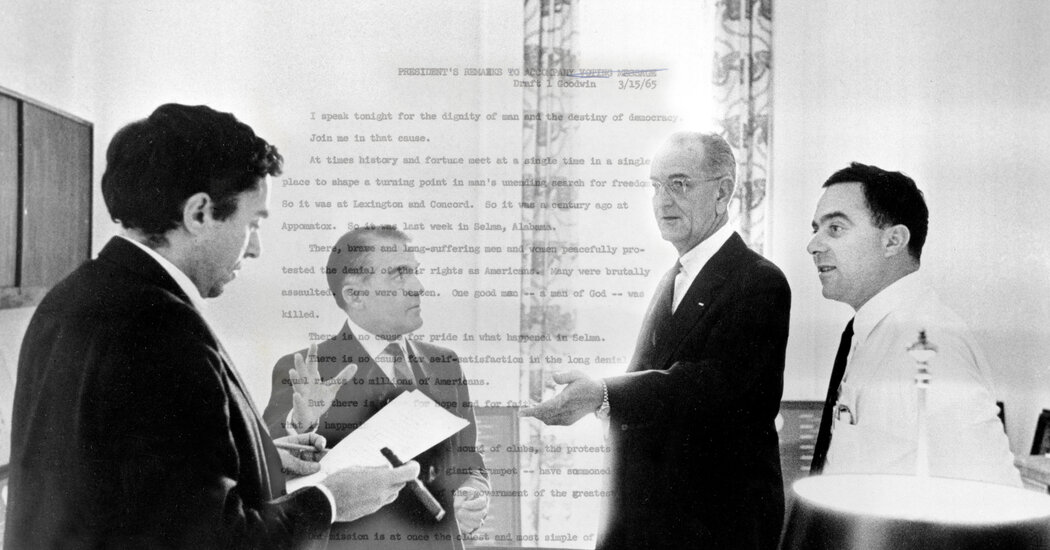
Doris Kearns was an assistant professor of history at Harvard University in 1972, teaching a class on the American presidency and starting the book that would mark the start of her extraordinary career as a popular historian, “Lyndon Johnson and the American Dream,” when Richard N. Goodwin walked into her office.
A legendary speechwriter for presidents John F. Kennedy, Lyndon Johnson, Eugene McCarthy and Robert F. Kennedy, Goodwin flopped himself down, she recalled, and asked, “Hi, are you a graduate student?”
“So I earnestly told him all about the presidency class I was teaching, and then quickly realized he was just teasing me,” she said. “We had dinner that night and engaged in conversation about L.B.J., J.F.K., the Red Sox and the ’60s. And I floated home that evening and told two close friends that I had met the man I wanted to marry.”
Dick-and-Doris, as they were colloquially known, as if a single entity, married in 1975, raised three boys and dedicated themselves to work that made them luminaries in their fields. He wrote about politics and society; she became the United States’ premier presidential historian on the strength of the Pulitzer Prize-winning “No Ordinary Time,” (1994) about Franklin and Eleanor Roosevelt, and six other best sellers.
For decades, the couple kept their archives, including more than 300 boxes of diaries, letters, scrapbooks, memos and speech drafts that Goodwin had saved, especially from his White House days in the 1960s, stored in the two-story barn on their Concord, Mass., property.
When he died in 2018, Kearns Goodwin sought an appropriate home for his papers: Spanning 1950 to 2014, they offer unique insight into 1960s policies and debates, and are a comprehensive record of Goodwin’s professional career. On Thursday, the Dolph Briscoe Center for American History at the University of Texas in Austin announced the acquisition of the Goodwin papers for $5 million, with Kearns Goodwin’s own archive donated to live alongside her husband’s.
Secret Letters Throughout History
For centuries, people have exchanged information in writing. Science is now casting new light on what was once meant to be private.
“When I saw how Dick saved everything from his lengthy and notable career, I was blown away,” said Don Carleton, the executive director of the Briscoe Center. “But I also told Doris that it should be a package deal. Doris is a hugely important cultural figure. Her own archive is valuable for scholars studying Lincoln, the Roosevelts, J.F.K., L.B.J. and so much more. I thought they belonged together, in the same building.”
What impressed Kearns Goodwin, in turn, was that the Briscoe Center sponsors and facilitates original research projects based on its archival holdings. “I was gratified that Dick’s papers wouldn’t lie dormant at Briscoe in a vault,” she said.
She also agreed to serve as an ambassador and adviser for the Briscoe Center, and to lecture periodically at the university. After working for Johnson as a White House Fellow, Kearns Goodwin accompanied him to Texas to work on his memoir; she said she was thrilled to return to Texas Hill Country, where Johnson’s ranch is now a National Park Service unit.
Goodwin’s archive encompasses his public service as a clerk for Supreme Court Justice Felix Frankfurter, his work as a House subcommittee investigator into the rigged game show “Twenty-One” (a story adapted into the 1994 film “Quiz Show”), as well as notes and memos that show how he helped shape national and international policies during the Kennedy and Johnson administrations. His archive illuminates critical issues in 1960s history, including Kennedy’s New Frontier, Johnson’s Great Society, the civil rights movement, the Vietnam War and the antiwar movement.
From a historian’s perspective, Goodwin’s speech drafts from 1960 to 1968 are a revelation. His command of history and literature became the cornerstone of Kennedy’s 1960 campaign speeches. It was Goodwin who invented the phrase “Alliance for Progress” to describe Kennedy’s Latin American policy. One draft of a long-forgotten speech in Alaska ended with Goodwin’s line: “It is not what I promise I will do, it is what I ask you to join me in doing.” Years later, material included in the collection shows, Jacqueline Kennedy wrote Goodwin to say that it was this wordplay that her husband recycled in his famous “Ask Not” inaugural address.
The documents reveal the wide berth Kennedy gave Goodwin. When the president noticed that there wasn’t a single Black recruit in the U.S. Coast Guard contingent during his inaugural parade, he tasked Goodwin with investigating. The resulting memorandum, included in the collection, led to the racial integration of the Coast Guard in 1962.
After Goodwin secretly met in Uruguay with Che Guevara, Fidel Castro’s closest confidant, he drafted a long psychological profile of the Marxist revolutionary for the president. “Behind the beard,” it begins, “his features are quite soft, almost feminine, and his manner is intense.” Among Goodwin’s memorabilia acquired by the University of Texas is a wooden cigar box from Guevara.
Goodwin’s diaries of Kennedy’s assassination brim with ticktock detail. He was among a small group in the White House when the president’s body arrived from Texas. His diary grapples with whether the coffin should be open or closed, the search for historical information about President Abraham Lincoln lying in state in the East Room, and where the 35th president should be buried. Working directly with Jacqueline Kennedy, Goodwin helped to bring to the grave site an eternal flame modeled after the Tomb of the Unknown Soldier in Paris.
In January 1964, Goodwin kept extensive notes during travels with the Peace Corps in East Africa, Iran, and Afghanistan. Then, in March, he was called to recast a speech on poverty for Johnson. Five drafts, all part of the collection, evolved into the special message to Congress on March 19, in which the phrase “war on poverty” struck a responsive chord. Goodwin now had a hot hand, and Johnson sought to bring him to the White House as his domestic affairs speechwriter.
Goodwin consulted his friend Robert F. Kennedy about whether he should take the job and recounted the attorney general’s advice in his diary, now at the Briscoe Center. “From a selfish point of view — you can think selfishly once in a while — I wish you wouldn’t, but I guess you have to,” Kennedy said to Goodwin. Although anything that makes Johnson “look bad, makes Jack look better, I suppose. But I guess you should do it. If you do, you have to do the best job you can, and loyally, there’s no other way.”
The archival material allows students of politics to follow the paper trail from a Goodwin draft to a Johnson speech, then to a Congressional bill, and finally to federal law. Goodwin had become Johnson’s indispensable White House wordsmith. “I want to put him in a hide-a-way over here,” Johnson told Secretary of State Dean Rusk, according to a March 21, 1964, taped White House conversation. “I’d just work him day and night.” So began an extraordinary partnership during the height of the Great Society — a time when the president summoned the Congress to pass one historic piece of legislation after another, legislation that would change the face of the country.
Goodwin resigned in late 1965, believing that the energy and focus for the Great Society was being siphoned to the escalating war in Vietnam, as he wrote in his memoir, “Remembering America.” In the months that followed, his friendship with Robert Kennedy deepened. When Kennedy went to South Africa in June 1966, Goodwin helped craft his “Ripple of Hope” speech. (Words from that shimmering human rights appeal are carved on Kennedy’s gravestone at Arlington National Cemetery.) Goodwin joined Kennedy’s campaign for president and was with him in the Los Angeles hospital room when he died.
After the assassination, Goodwin retreated to Maine, shattered by Kennedy’s death. Four years later, he met Kearns Goodwin at Harvard, and they went on to become a team of writers, each editing the other’s work.
When Vice President Al Gore wanted help drafting his presidential concession speech in 2000, after the Supreme Court stopped the Florida recount, he turned to Goodwin, still known as one of the most gifted speechwriters in the Democratic orbit.
While Goodwin’s papers are a window into the inner workings of important presidencies, the Kearns Goodwin boxes are riveting to scholars with an interest in American history and the writing of it. Her well-organized trove of primary source material for all of her books, including “Team of Rivals” (2005) and “The Bully Pulpit” (2013) are eminently accessible. She saved “all the research and primary sources related to every book I had written,” she said, “from the original idea for how to tell the story, to the interviews, to the early outlines, the primary sources, copies of handwritten letters.”
“Oh, how I love old handwritten letters and diaries,” she enthused. “I feel as if I’m looking over the shoulder of the writer. History comes alive!”
Douglas Brinkley is the Katherine Tsanoff Brown Chair in Humanities and Professor of History at Rice University and the author of the forthcoming “Silent Spring Revolution: John F. Kennedy, Rachel Carson, Lyndon Johnson, and the Great Environmental Awakening.”




